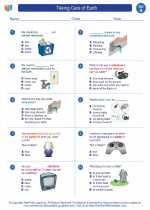Taking Care of Earth -> electric motors
What is an Electric Motor?
An electric motor is a device that uses the principles of electromagnetism to convert electrical energy into mechanical energy. It consists of a coil of wire (the armature) that is placed in a magnetic field. When an electric current is passed through the coil, it experiences a force and starts to rotate, thus producing mechanical motion.How Does an Electric Motor Work?
Electric motors work on the principle of electromagnetic induction. When an electric current flows through a wire in the presence of a magnetic field, a force is exerted on the wire, causing it to move. In an electric motor, this movement is used to drive a shaft or perform other mechanical tasks.Parts of an Electric Motor
- Armature: The coil of wire that is the moving part of the motor. - Commutator: A device that reverses the direction of the current in the armature to keep it rotating in the same direction. - Brushes: Conductive contacts that deliver current to the commutator. - Magnetic Field: Permanent magnets or electromagnets that create the magnetic field in which the armature rotates.Types of Electric Motors
- DC Motors: Direct current (DC) motors have a commutator and brushes to reverse the current in the armature. - AC Motors: Alternating current (AC) motors do not have a commutator and are powered by alternating current. - Brushless Motors: These motors use electronic controllers to switch the current in the armature, eliminating the need for brushes and commutators.Applications of Electric Motors
[Electric Motors] Related Worksheets and Study Guides:
.◂Science Worksheets and Study Guides First Grade. Taking Care of Earth
Study Guide Taking Care of Earth
Taking Care of Earth  Worksheet/Answer key
Worksheet/Answer key Taking Care of Earth
Taking Care of Earth  Worksheet/Answer key
Worksheet/Answer key Taking Care of Earth
Taking Care of Earth  Worksheet/Answer key
Worksheet/Answer key Taking Care of Earth
Taking Care of Earth  Vocabulary/Answer key
Vocabulary/Answer key Taking Care of Earth
Taking Care of Earth  Vocabulary/Answer key
Vocabulary/Answer key Taking Care of Earth
Taking Care of Earth 

 Worksheet/Answer key
Worksheet/Answer key
 Worksheet/Answer key
Worksheet/Answer key
 Worksheet/Answer key
Worksheet/Answer key
 Vocabulary/Answer key
Vocabulary/Answer key
 Vocabulary/Answer key
Vocabulary/Answer key

The resources above cover the following skills:
Concepts of Physical Science (SB1, SB2, SB3, SB4)
The student demonstrates an understanding of the structure and properties of matter by classifying matter according to physical properties (i.e., color, size, shape, weight, texture, flexibility).